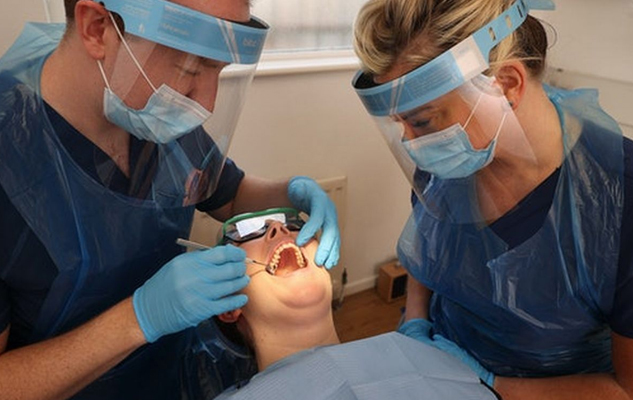There are plenty of reasons to be drawn to becoming a dental assistant in Canada. This career offers job security, competitive wages, and truly fulfilling work. Another key advantage of becoming a dental assistant is the accelerated learning that you can undertake – it does not take more than a year to become a dental assistant. If you would like to get a better grasp of what dental assistants do, make sure to check out our article, The Roles and Duties of a Dental Assistant.
That said, this article delves into the differences between a Level I and Level II Dental Assistant. We’ll talk about the scope of training through a dental assisting program, differences in job roles, and more. By the time you’re done reading this, you’ll be one step closer to making an informed decision about which level of dental assistant you would like to pursue.
Let’s get started!
What is a Level I Dental Assistant and a Level II Dental Assistant?
Dental assistants, no matter what level, work closely and under the supervision of a dentist. They are assigned tasks that mostly deal with the patient before and after the dentist meets with them. The Canadian Dental Assistants Association subdivides this profession into two categories: Dental Assistant Level 1 and Dental Assistant Level 2.
Level I dental assistants are classified as “chair side” assistants, which means their tasks revolve around preparing and seating patients. However, level I dental assistants may also perform other duties like charting patient information, sterilizing instruments, pouring and trimming cast models, etc.
Meanwhile, level II dental assistants, also known as intra-oral dental assistants, are required to complete the additional intra-oral training that’s required for them to be able to handle additional responsibilities on top of the responsibilities associated with level I dental assistants. Level II dental assistants are also required to complete certification requirements in most areas of Canada.
Now that we’ve talked briefly about what level I and level II mean for the dental assisting profession, we can have a closer look at their differences, starting with what we’ve already mentioned: training.

Difference #1: Dental Assistants Training
Currently, there is no formal training that only encompasses level I dental assisting skills in Canada. Today’s programs combine chairside dental assisting skills and intra-oral dental assisting skills – level I and II together. So, even for everyone who would like to pursue a career as a level I dental assistant, going through a Dental Assistant Program (Intra-Oral Level I & II) is still a way to gain a competitive advantage.
As for aspiring level II dental assistants, they are required to have the needed intra-oral training. This means they must undergo formal education through a Dental Assistant Program (Intra-Oral Level I & II).
To get into this dental assistants program, completion of high school with an emphasis on sciences is required. Additionally, some dental assisting programs may require their students to maintain a valid CPR Level C Certificate.
A Dental Assistant Program would typically take a year to complete. It equips the learner with skills for chairside dental assisting (level I) and intra-oral dental assisting (level II). The program would cover mandatory skills such as:
- Chairside dental assisting
- Exposing dental radiographs
- Oral hygiene instruction
- Dietary counselling relative to oral health
- Selective coronal polishing
- Applying and removing dental dam, clamps, matrices, and wedges
- Taking preliminary impressions
- Applying treatment liner
- Applying and removing matrix and wedge
- Applying fluoride
- Applying pit and fissure sealant
- Applying desensitizing agents
- Applying topical anesthetic
- Performing tooth whitening using trays
Difference #2: Dental Accreditation
Though certification will increase your hireability and give you the opportunity for a more competitive salary, it is not required to work as a level I dental assistant.
Meanwhile, being a level II dental assistant is considered a “restricted health care occupation.” This means that though the profession is self-regulated, most provinces will require a license, making you a certified dental assistant.
In these provinces, after the aspiring level II dental assistant has finished the program, they must pass the exam given by the National Dental Assisting Examining Board (NDAEB.) The mandatory skills listed in the previous section are required before an individual is qualified to take this exam.
Note – You can confirm if the NDAEB certificate is required in your province by contacting the Dental Assisting Regulatory Authority.
Toronto Dental Assistant Program
Reach your career goals with Cestar College’s fast-tracked Dental Assistant Program.
✅ Accelerated Program
✅ Small Class Sizes
✅ Financial Assistance
✅ Hands-On Experience

Difference #3: Dental Assisting Responsibilities
Now let’s talk about the scope of dental assistant responsibilities or job tasks that these two dental assisting levels have. Take note that individuals who have completed the Dental Assistant Program (Intra-Oral Level I & II) and have been certified still have a choice if they would like to opt for a level I dental assistant job.
LEVEL I DENTAL ASSISTANTS
Level I dental assistants can be tasked with the following:
- Preparing the patient for the dental procedures
- Charting the patient’s information
- Preparing and sterilizing the area as well as the instruments used for the dental procedures
- Pouring and making cast models
- Relaying patient care instructions after dental procedures
- Ordering and maintaining the stock of dental supplies and dental materials required for dental procedures
LEVEL II DENTAL ASSISTANTS
The full list of services that a level II dental assistant can provide in Ontario is outlined in the Ontario Dental Assistants Association scope of practice here. These are expanded services that go into Orthodontics and Prosthodontics. Level II dental assistants can also do the responsibilities of level I dental assistants. And on top of that, they are capable of doing these specialized tasks:
- Exposing dental radiographs
- Obtaining impressions and occlusal records
- Placing and removing dental dam clamps
- Applying desensitizing agents, anesthetics, and whitening agents to the coronal portions of the teeth
- Applying materials to prepare the surface of the teeth for pit and fissure sealants
- Applying pit and fissure sealants
- Mechanical polishing
Difference #4: Dental Assistant Salary
Because level II dental assistants have more specialized responsibilities, they have a higher hourly wage than the level I dental assistants. In the past section, we’ve made it clear that dental assistants who have completed formal education and possess a license can still opt for a level I dental assistant job.
New Grad Certified Dental Assistant Salaries
According to the Ontario Dental Assistants Association, the hourly rate of a new grad certified dental assistant (level I dental assistant / chairside) is $20.34. Meanwhile, the hourly rate of a new grad certified dental assistant (level II dental assistant / intra-oral) is $22.42.
Experienced Certified Dental Assistant Salaries
For both levels, years of experience would boost the hourly wage higher. For a certified dental assistant (level II dental assistant / chairside) with 2-5 years of experience, the hourly rate would go up to $21.80. Meanwhile, a certified dental assistant (level II dental assistant / intra-oral) with 2-5 years of experience would have an hourly rate of $22.97.
That means that one average, a level II dental assistant / intra-oral dental assistant will earn $1.17 to $2.08 more per hour than a level I dental assistant / chairside dental assistant depending on years of experience.
Do You Feel Drawn To Dental Assisting?
Do you feel pulled towards becoming a level I or level II dental assistant? If so, getting a top-notch, NDAEB-approved education is the way to go!
If you’re ready to take the next step, we are here for you. Cestar College in Toronto is one of the top dental assisting accredited institutions that can provide you with the comprehensive Dental Assistant Program (Intra-Oral Level I & II) that you’d need to succeed in the dental assisting profession.
Got any questions for us? Feel free to reach out and we’ll be more than happy to help!
Why Choose Cestar College’s Dental Assistant Program?
By applying to Cestar College’s Dental Assistant (Intra-Oral Level I & II) program, you’re choosing:
- One of the most comprehensive curriculums in Ontario, covering all aspects of dentistry available to Dental Assistants.
- A dental assisting program (Intra-Oral Level I & II) that is NDAEB-approved.
- An accredited college for providing formal training for national dental assisting, featuring HARP-approved dental radiography training.
- 1245 hours of learning, including an internship, giving you the benefits of real-life work experience while still in school.
- Small class sizes that foster discussion-based education and provide a welcoming learning environment for all students.
- Dedicated instructors with years of experience who take pride in seeing their students succeed.
- A challenging but rewarding learning experience full of support from all Cestar College faculty and administrators.
If you want to learn more about Cestar College’s Dental Assistant (Intra-Oral Level I & II) program or have any questions please feel free to contact us!
One of our representatives will be more than happy to provide further information concerning any of your questions regarding the program start date, international students, student success, admission requirements, and so on.


